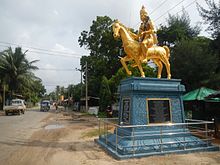Cankili II
| Cekaracacekaran IX Cankili II | |
|---|---|
| King of Jaffna | |
 King Sangiliyan Statue in Jaffna | |
| Reign | 1617–1619 |
| Predecessor | Ethirimana Cinkam (Parasasekaran VIII) |
| Successor | Portuguese conquest |
| Died | 1623 |
| Tamil | சங்கிலி குமாரன் |
| Sinhala | සංකිලි |
| House | Aryacakravarti dynasty |
Cankili II (Tamil: சங்கிலி குமாரன்) (died 1623) was the self-proclaimed last king of the Jaffna kingdom and was a usurper who came to throne with a palace massacre of the royal princess and the regent Arasakesari in 1617. His regency was rejected by the Portuguese colonials in Colombo, Sri Lanka. His reign was secured with military forces from the Thanjavur Nayaks and Malabari Corsairs. He was defeated by the Portuguese in 1619 and was taken to Goa and hanged. With his death the Aryacakravarti line of Kings who had ruled the kingdom for over 300 years came to an end.[1]
Precipitous actions
With the death of Ethirimana Cinkam in 1617, there were three claimants to the throne. One was Cankili II, a nephew of the king. The other the claimants were the king’s young son and a group of pro-Portuguese Mudaliyars. Eventually Cankili II became the king under the name Segarasasekaran VIII (1617–1619) through a palace massacre. As he was not able to get the Portuguese authorities in Mannar or Colombo to agree to his over rule and regency due to opposition for him from the pro Portuguese Mudaliars, he requested king Raghunatha Nayak to send military help and allowed the corsairs from Malabar to use a base in Neduntivu that posed a threat to Portuguese shipping through Palk Straight.[2]
Downfall
By June 1619, there were two Portuguese military expeditions to the Jaffna kingdom: a naval expedition that was repulsed by Khem Nayak and the Malabari corsairs, and a land expedition by Phillippe de Oliveira and his army of 5000, which was able to defeat Cankili.[2] Cankili's remaining soldiers were beheaded by Portuguese, and Cankili himself was taken to Goa and hanged. The surviving members of the royal family were also taken to Goa and asked to become monks or nuns in the holy orders. Most obliged, and their celibacy avoided the production of further claimants to the Jaffna throne.[3][4]
See also
Notes
- ^ Vriddhagirisan, Nayaks of Tanjore, p.77-8, 80-1,90-1
- ^ a b Vriddhagirisan, Nayaks of Tanjore, p.80-1,91-2
- ^ Abeysinghe, T Jaffna Under the Portuguese, p.58-63
- ^ Gnanaprakasar, S A critical history of Jaffna, p.153-172
References
- Vriddhagirisan, V (2007). Nayaks of Tanjore. New Delhi: Asian Educational Services. pp. V, 77–8, 80–1, 90–2. ISBN 978-8120609969.
- Abeysinghe, Tikiri (2005). Jaffna under the Portuguese. Colombo: Stamford Lake. p. 66. ISBN 955-1131-70-1.
- Kunarasa, K (2003). The Jaffna Dynasty. Johor Bahru: Dynasty of Jaffna King’s Historical Society. p. 122. ISBN 955-8455-00-8.
- Gnanaprakasar, Swamy (2003). A Critical History of Jaffna (review of Yalpana Vaipava Malai). New Delhi: Asian Educational Services. p. 122. ISBN 81-206-1686-3.
